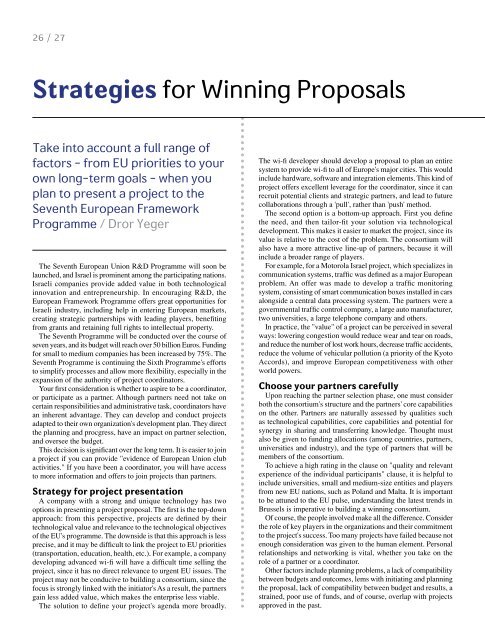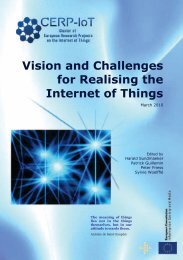Télécharger le document - Eurosfaire
Télécharger le document - Eurosfaire
Télécharger le document - Eurosfaire
You also want an ePaper? Increase the reach of your titles
YUMPU automatically turns print PDFs into web optimized ePapers that Google loves.
26 / 27<br />
Strategies for Winning Proposals<br />
Take into account a full range of<br />
factors - from EU priorities to your<br />
own long-term goals - when you<br />
plan to present a project to the<br />
Seventh European Framework<br />
Programme / Dror Yeger<br />
The Seventh European Union R&D Programme will soon be<br />
launched, and Israel is prominent among the participating nations.<br />
Israeli companies provide added value in both technological<br />
innovation and entrepreneurship. In encouraging R&D, the<br />
European Framework Programme offers great opportunities for<br />
Israeli industry, including help in entering European markets,<br />
creating strategic partnerships with <strong>le</strong>ading players, benefiting<br />
from grants and retaining full rights to intel<strong>le</strong>ctual property.<br />
The Seventh Programme will be conducted over the course of<br />
seven years, and its budget will reach over 50 billion Euros. Funding<br />
for small to medium companies has been increased by 75%. The<br />
Seventh Programme is continuing the Sixth Programme's efforts<br />
to simplify processes and allow more f<strong>le</strong>xibility, especially in the<br />
expansion of the authority of project coordinators.<br />
Your first consideration is whether to aspire to be a coordinator,<br />
or participate as a partner. Although partners need not take on<br />
certain responsibilities and administrative task, coordinators have<br />
an inherent advantage. They can develop and conduct projects<br />
adapted to their own organization's development plan. They direct<br />
the planning and procgress, have an impact on partner se<strong>le</strong>ction,<br />
and oversee the budget.<br />
This decision is significant over the long term. It is easier to join<br />
a project if you can provide "evidence of European Union club<br />
activities." If you have been a coordinator, you will have access<br />
to more information and offers to join projects than partners.<br />
Strategy for project presentation<br />
A company with a strong and unique technology has two<br />
options in presenting a project proposal. The first is the top-down<br />
approach: from this perspective, projects are defined by their<br />
technological value and re<strong>le</strong>vance to the technological objectives<br />
of the EU's programme. The downside is that this approach is <strong>le</strong>ss<br />
precise, and it may be difficult to link the project to EU priorities<br />
(transportation, education, health, etc.). For examp<strong>le</strong>, a company<br />
developing advanced wi-fi will have a difficult time selling the<br />
project, since it has no direct re<strong>le</strong>vance to urgent EU issues. The<br />
project may not be conducive to building a consortium, since the<br />
focus is strongly linked with the initiator's As a result, the partners<br />
gain <strong>le</strong>ss added value, which makes the enterprise <strong>le</strong>ss viab<strong>le</strong>.<br />
The solution to define your project's agenda more broadly.<br />
The wi-fi developer should develop a proposal to plan an entire<br />
system to provide wi-fi to all of Europe's major cities. This would<br />
include hardware, software and integration e<strong>le</strong>ments. This kind of<br />
project offers excel<strong>le</strong>nt <strong>le</strong>verage for the coordinator, since it can<br />
recruit potential clients and strategic partners, and <strong>le</strong>ad to future<br />
collaborations through a 'pull', rather than 'push' method.<br />
The second option is a bottom-up approach. First you define<br />
the need, and then tailor-fit your solution via technological<br />
development. This makes it easier to market the project, since its<br />
value is relative to the cost of the prob<strong>le</strong>m. The consortium will<br />
also have a more attractive line-up of partners, because it will<br />
include a broader range of players.<br />
For examp<strong>le</strong>, for a Motorola Israel project, which specializes in<br />
communication systems, traffic was defined as a major European<br />
prob<strong>le</strong>m. An offer was made to develop a traffic monitoring<br />
system, consisting of smart communication boxes instal<strong>le</strong>d in cars<br />
alongside a central data processing system. The partners were a<br />
governmental traffic control company, a large auto manufacturer,<br />
two universities, a large te<strong>le</strong>phone company and others.<br />
In practice, the "value" of a project can be perceived in several<br />
ways: lowering congestion would reduce wear and tear on roads,<br />
and reduce the number of lost work hours, decrease traffic accidents,<br />
reduce the volume of vehicular pollution (a priority of the Kyoto<br />
Accords), and improve European competitiveness with other<br />
world powers.<br />
Choose your partners carefully<br />
Upon reaching the partner se<strong>le</strong>ction phase, one must consider<br />
both the consortium's structure and the partners' core capabilities<br />
on the other. Partners are naturally assessed by qualities such<br />
as technological capabilities, core capabilities and potential for<br />
synergy in sharing and transferring know<strong>le</strong>dge. Thought must<br />
also be given to funding allocations (among countries, partners,<br />
universities and industry), and the type of partners that will be<br />
members of the consortium.<br />
To achieve a high rating in the clause on "quality and re<strong>le</strong>vant<br />
experience of the individual participants" clause, it is helpful to<br />
include universities, small and medium-size entities and players<br />
from new EU nations, such as Poland and Malta. It is important<br />
to be attuned to the EU pulse, understanding the latest trends in<br />
Brussels is imperative to building a winning consortium.<br />
Of course, the peop<strong>le</strong> involved make all the difference. Consider<br />
the ro<strong>le</strong> of key players in the organizations and their commitment<br />
to the project's success. Too many projects have fai<strong>le</strong>d because not<br />
enough consideration was given to the human e<strong>le</strong>ment. Personal<br />
relationships and networking is vital, whether you take on the<br />
ro<strong>le</strong> of a partner or a coordinator.<br />
Other factors include planning prob<strong>le</strong>ms, a lack of compatibility<br />
between budgets and outcomes, <strong>le</strong>ms with initiating and planning<br />
the proposal, lack of compatibility between budget and results, a<br />
strained, poor use of funds, and of course, overlap with projects<br />
approved in the past.

















